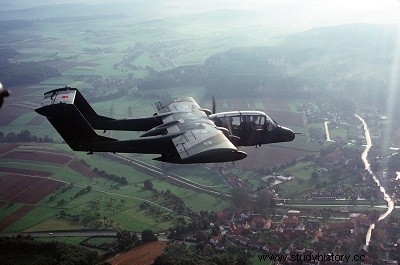
In 1967, the first OV-10As — from the COIN program — were delivered to the Marine Corps and the USAF in Vietnam. Despite its modest performance, this aircraft, much appreciated by pilots, does a considerable job, especially in the armed missions of FAC. At the Pentagon, during this time, data was fixed for a future close tactical support aircraft, designated AX.
It was now accepted that the propeller-driven turboprop of the OV-10A could advantageously be to the turbojet. The emphasis, however, had to be on simplicity, if not rusticity. It was necessary to carry very important offensive loads (area in which COIN planes were disadvantaged) and to be able to withstand heavy fire.
This aircraft was also to perform FAC missions. In fact, it was no longer a machine specialized in guerrilla warfare, but capable of any close tactical support. Tests were carried out with the 0V-10, the Armed Porter, the O-2TT and other devices. None proved satisfactory. On the other hand, a more powerful craft would have been too fast for visual observation and identification. The AX program inherited from the Vietnam War finally gave rise to a new aircraft, the Fairchild-Republic A-10A, today one of the USAF's major programs.
In March 1968, a detachment of six F-IIIAs was sent to Vietnam. This deployment had been decided hastily (the aircraft began to operate in October 1967), to demonstrate the operational qualities of this controversial aircraft. The F-111A, ex-TFX, was a tactical and strategic fighter introducing new techniques, including the famous variable geometry. In the three weeks which followed its arrival in Vietnam, one lost half of it (three F-IIIA out of six). Then they were grounded. It was a real bad luck — as the pilots say:the accidents came from the malfunctioning of a tail piece, and not from enemy action.
On the other hand, we recognized that the F-IIIA had carried out very dangerous missions, deep inside North Vietnamese territory, without the slightest support, neither in-flight tankers, nor ECM jamming planes, nor fighter escorts. The F-IIIA did without all that.
Finally, it demonstrated its extraordinary ability to locate, fix and destroy a target during operations in the fall of 1972. The pilots called it a "smart airplane" by analogy with the "smart bombs" used from of this period. The F-111s flew more than 4,000 war missions in less than three months, some of them in monsoon storms that grounded all other aircraft. (On November 8, 1972, for example, the weather prevented the Americans from flying more than 20 missions over North Vietnam; all of them were carried out by F-IIIs).
They had the lowest casualty percentage of the offensive, after the USAF A-7Ds—significantly less than 1%! From 1968, the attack on the objectives in the North was no longer "a piece of cake". Hanoi's DCA, in its concentration, power and precision, now proved superior to anything seen in air history - especially over Germany in 1944-45. Air-to-ground vehicles were needed for so-called “defense suppression” missions. The pilots demanded, in replacement of the old Bullpup, a machine that simply had to be dropped without having to guide it to the objective, which would allow the assailant not to expose himself. In 1965, the Shrike ARM (Anti Radar Missile:a device that automatically struck enemy radars) had been put into service – with disastrous results; but, by 1968, he was fulfilling his mission perfectly.
